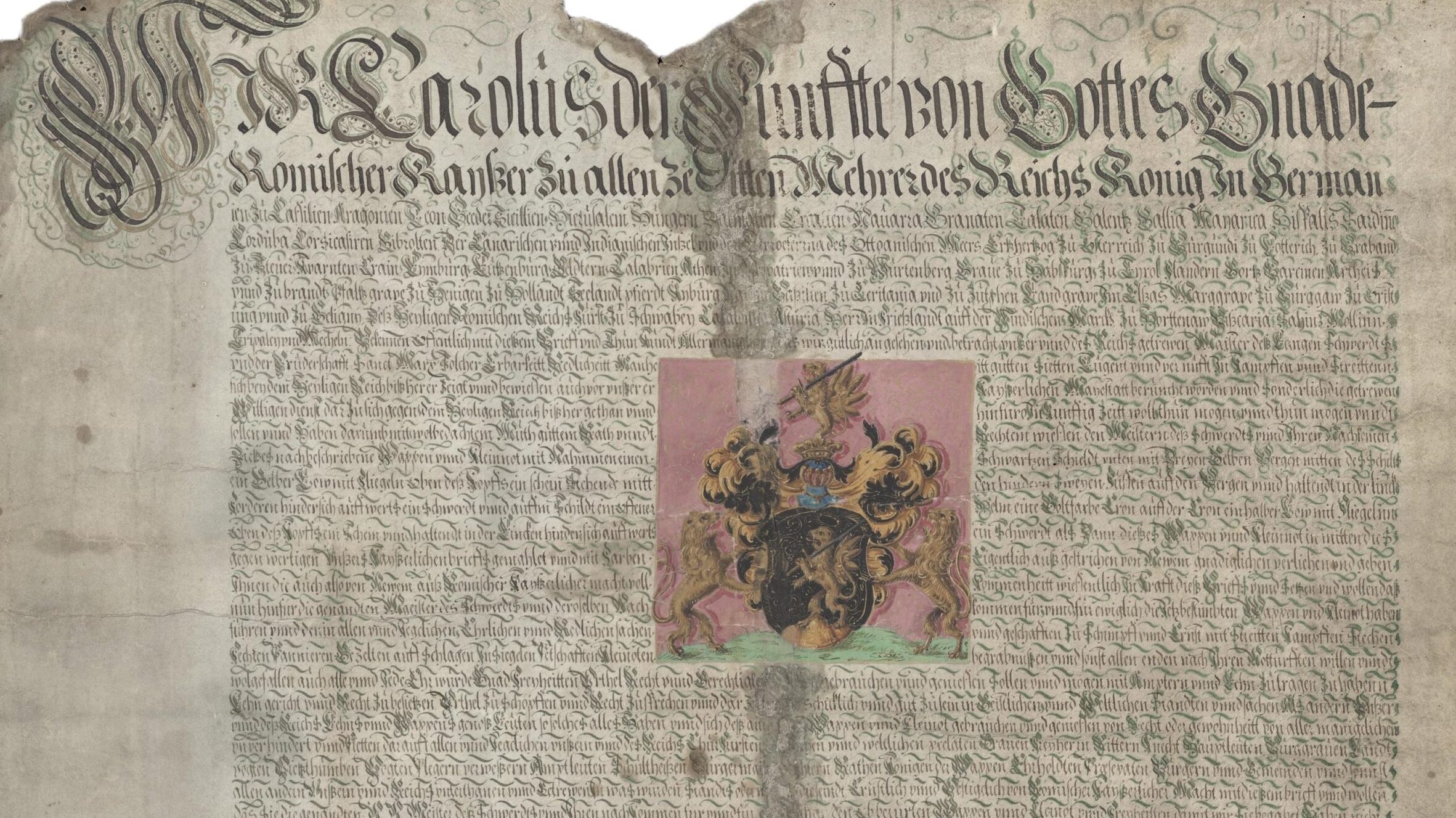This article is also available in German.
Frankfurt’s Masters of the Sword and Their Lost Emblem – Part I
Half a millennium ago, the Imperial City of Frankfurt hosted a curious society known as Masters of the Long Sword, or Marxbrüder. This was the world’s first fencing guild. Its members followed a somewhat formalized curriculum in fencing with various weapons – most notably the long sword – and could earn the title Master of the (Long) Sword, allowing them to teach students for a fee and gain a highly respected qualification in martial arts.
This article assumes a basic familiarity with the Marxbrüder and will not revisit their general history in detail. Instead, it focuses on a particularly niche yet fascinating aspect of their story: their noble coat of arms. Subsequent articles will delve into their broader history and sites in Frankfurt that preserve their legacy.
For those unfamiliar, here’s a mini “lore dump” explaining what made the Marxbrüder remarkable and why they remain shrouded in myth in the historical fencing community:
- They were world’s first fencing guild, founded sometime in the 15th century.
- Granted by the Emperor, they held a de jure monopoly on teaching fencing in the Holy Roman Empire for around a century, until the rival Federfechter guild in Prague received a similar privilege, creating a duopoly.
- For several centuries, they ran a decentralized civilian organization with a semi-democratic structure,spanning from today’s Kaliningrad to Basel, and meeting in Frankfurt twice a year during trade fairs – which often required several weeks of travel.
- Members who completed the curriculum were awarded a certificate of sword mastery, a recognized honour conferring martial recognition and social standing for civilians.
- Several Marxbrüder rose to prominence, including probable early member Hans Talhoffer, renowned fencing master and author; Onophrius Sokh, imperial bodyguard; and Hans Keesebrod, master builder and politician (whose name somewhat amusingly translates to “cheese sandwich”).
The guild received its formal privileges from the Holy Roman Emperors, beginning with Frederick III on 20 August 1487. These privileges were subsequently renewed and expanded by each emperor up to Leopold I. in 1688. A full list of the thirteen Imperial privileges can be found in Schaer (1901).
A Coat of Arms Gone Missing
To this day, all Imperial privileges lie beneath the city of Frankfurt in the depth magazine of the city archive – except for two: Strangely enough, the centerpiece of the convolute is missing: the 1541 issuance of a noble coat of arms by Charles V. in Regensburg, along with its 1670 augmentation by Leopold I. in Vienna. These two documents are especially significant because they grant a civilian organization the right to bear a noble coat of arms. Moreover, they contain the long-lost Marxbrüder coat of arms, whose appearance remains uncertain to this day.
Hold on, but I saw it on Wikipedia? True, two versions of the arms circulate through the internet. However, there’s problems with them:
- They are of unknown provenance, which is a convoluted way to say we don’t know their source or veracity.
- More pressingly, they aren’t the Marxbrüder Coat of Arms. At least neither the original version issued by Charles V. in 1541, nor the version augmented 1670 by Leopold I. in correct tincture (color). They merely are monochrome copies of what appear to be the augmented arms, created by unknown artists. Version 2 features a monogram AC or AE, but we don’t know what name that stands for. And, most critically, the actual coats of arms along with their letters of privilege continue to be lost.
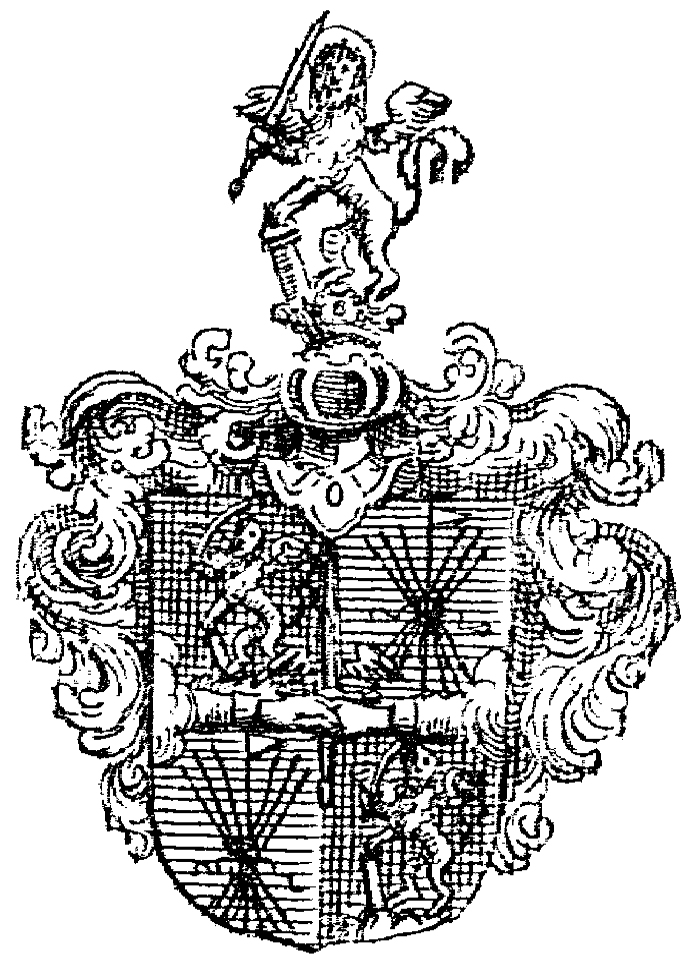
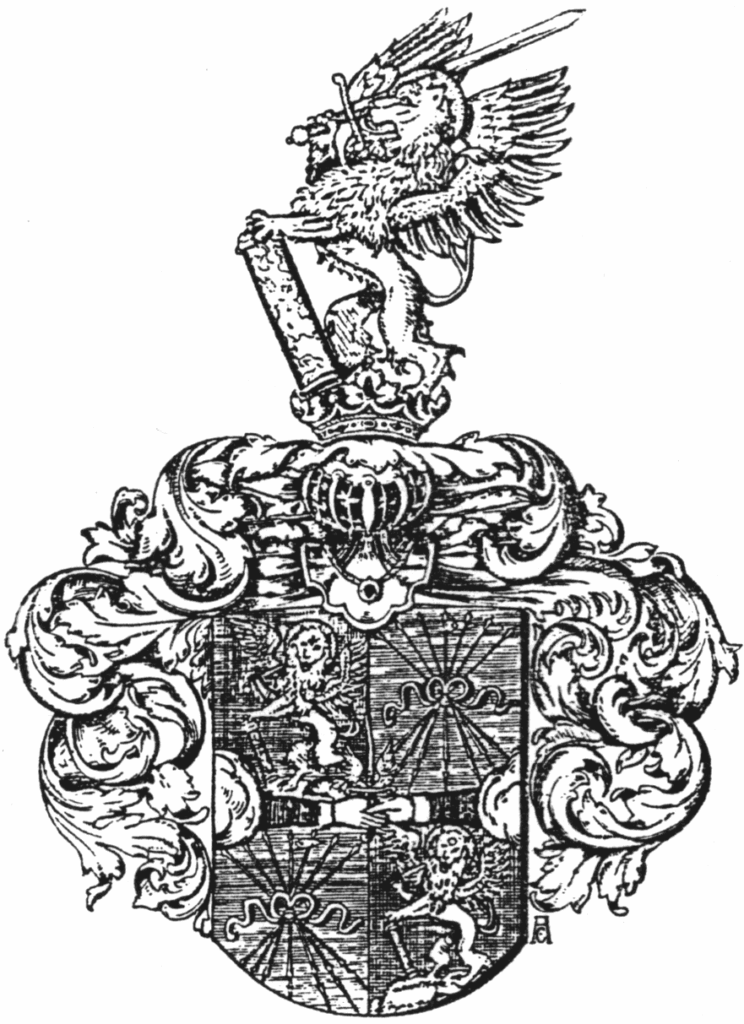
The Hunt Begins: Searching for the 1541 Imperial Privilege
An unsatisfying interim conclusion, to say the least. I have little patience for loose ends, so I set out on a treasure hunt, beginning with the original coat of arms issued by Charles V.
In the age of digital archives, how hard could it be? All I had to do was comb through the databases of Frankfurt, Regensburg, Nuremberg, Augsburg, Vienna, Breslau, Prague, … You get the idea. The decentralized nature of the Marxbrüder guild coupled with the fragmented nature of the Holy Roman Empire itself (further complicated by several major wars) made it entirely plausible that the charter could have ended up in any number of cities across what is now Germany, Austria, Switzerland, the Netherlands, the Czech Republic, or Poland.
Countless (and late) hours, I spammed central European archive information systems and conventional search machines with keywords I hoped would lead me to the letters (e.g., “Marxbrüder” and “Charles V.” and “1541” etc.). I’m acquainted to falling into research rabbit holes, but this time, I found myself nursing a quiet grudge against the early modern culprit who dared to remove the privileges from their rightful place. They could’ve at least returned them after they were done showing off.
Ironically, the guild’s statutes from the late 15th century are crystal clear: anyone borrowing a copy of the privileges was bound by oath to return them. Evidently, our anonymous eternal lender was unmoved by such formalities.
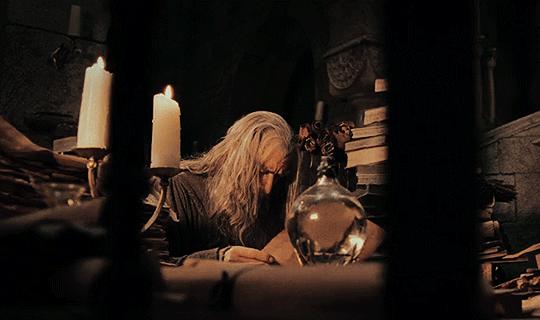
A Glimmer in Gießen
After yet another exhaustive search, I came across a curious document in the charter collection of the University of Gießen: a 1541 letter of privilege issued by Emperor Charles V. in Regensburg to certain “Masters of the Sword”. Could this be the elusive privilege that first granted the Marxbrüder their coat of arms?
My heart leapt – this had to be it. Opening with a solemn intitulatio, rendered in the ornate chancery script typical for imperial charters, the letter certainly looked the part:
We, Charles the Fifth, by grace of God Roman Emperor, ever the augmenter of the Empire, and King in Germany, of Castile, Aragon, León, both Sicilies, Jerusalem, Hungary, Dalmatia, Croatia, Navarre, Granada, Toledo, Valencia, Gaul, Ma[llorca] …
Although switching to a more prophane cursive, the scribe took the due time to enumerate five further lines of titles, culminating in:
Lord in Friesland, in the Windic March, at Pordenone, Biscaya, at Molin, at Salins, at Tripoli and Mechelen, etc.
Upong examining the facsimile more closely, however, my excitement slowly gave way to disbelief: The central space that should have contained the arms – was blank. Empty. Had certain Marxbrüder not only relocated the privilege from Frankfurt without returning it, but also dared to steal the coat of arms itself? If so, where had it gone? Into some private collection?
Having accepted the reality that the original arms may be lost forever, I turned to transcription. Perhaps, somewhere in the text, a blazon remained – a formal description of the heraldic figures and tinctures that once adorned the page.
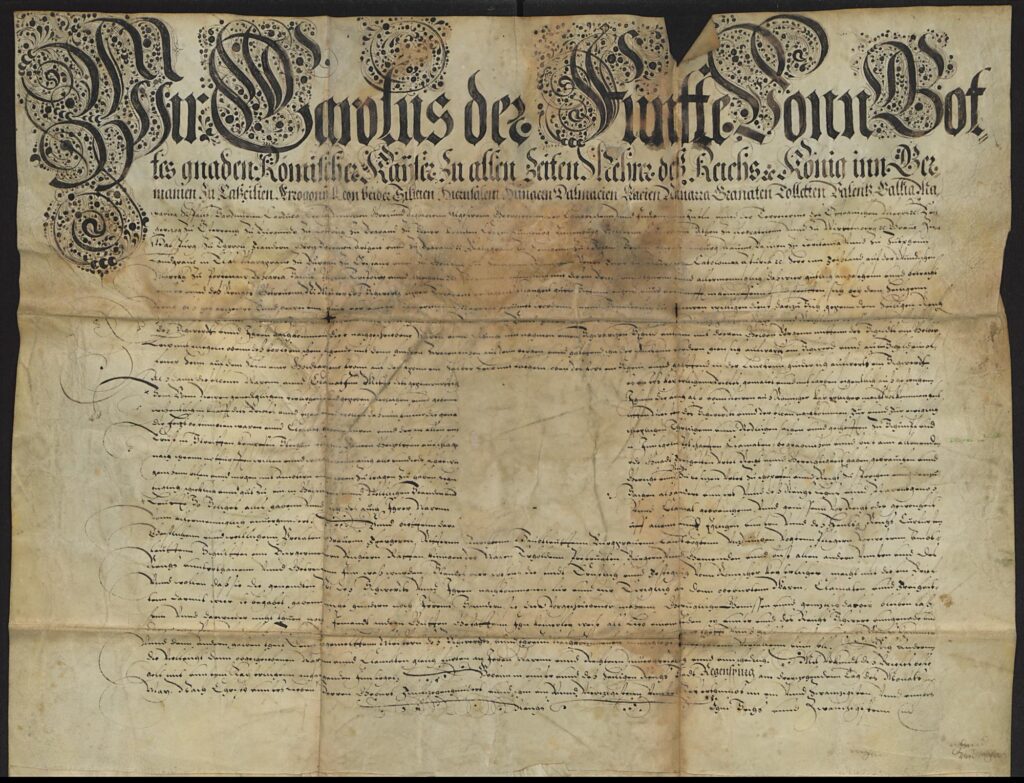
For brevity, I’ll omit the full transcription here (though the Appendix contains more) and will instead highlight the relevant passage beginning at line 13:
[We grant the masters] of the sword and their successors this coat of arms and crest as described below: a black shield whose bottom shows three yellow mountains, at the center of the shield a yellow lion with wings, above the head a halo, with its hindlegs on the mountains, and holding in its left front claw a sword upright. And above the shield an open helmet, on the helmet a golden crown, on the crown a yellow lion with wings, above the head a halo, and holding in its left a sword upright.
So, while the augmented arms as we know them seemed to feature a quartered shield depicting a similar lion in fields 1 and 4 and on its crest, the original arms focused on just the lion. We now also know the tincture: The shield was black and the lion was golden.
Amidst deciphering the scribe’s scrawl – made even more challenging by deep fold marks in the parchment and brownish spots from ink oxidation – I developed an egregious idea: What if this wasn’t the original letter of privilege at all, but merely a copy, sans the coat of arms? After all, we know that several such vidimi exist, including in Frankfurt. The hypothesis that this may be a verbatim copy of the original letter, gave me fresh ammunition: a wealth of new keywords for further archival research. Most importantly, I now knew that, in the letter, the guild was usually not called “Marxbrüder” (Brotherhood of St. Mark) or similar, but simply “Meister des Schwerts” or “Masters of the Sword”.
A Breakthrough in Basel?
Armed with this insight, I was able to pinpoint what I believed to be another copy of the privilege – this time in Basel. Unlike the Gießen letter, this one lacked even a digital facsimile. I had to rely on the metadata (“Charles V.”, “1541”, and “Masters of the Sword”) to deduce that his might be the document I had been chasing for months.
I contacted the Basel City Archive and requested a digital high-resolution digital facsimile. Their reply was prompt and gracious: it could be provided for a small fee, though the 500-year-old letter would first need restoration, which might take some time.
Mindful of their time and effort, I asked if, by any chance, this letter contained a small depiction of a coat of arms in the center. If not, there would be no need to proceed further.
The archivist confirmed that this was the case. Delighted, I paid the fee and exercised patience for another couple of days (which, in the grander scheme of things, didn’t matter anymore).
And then, I received it: The original Marxbrüder coat of arms, issued by Holy Roman Emperor Charles V. on 13 May 1541 in Regensburg. Below, I attach the high-resolution reproduction I received.
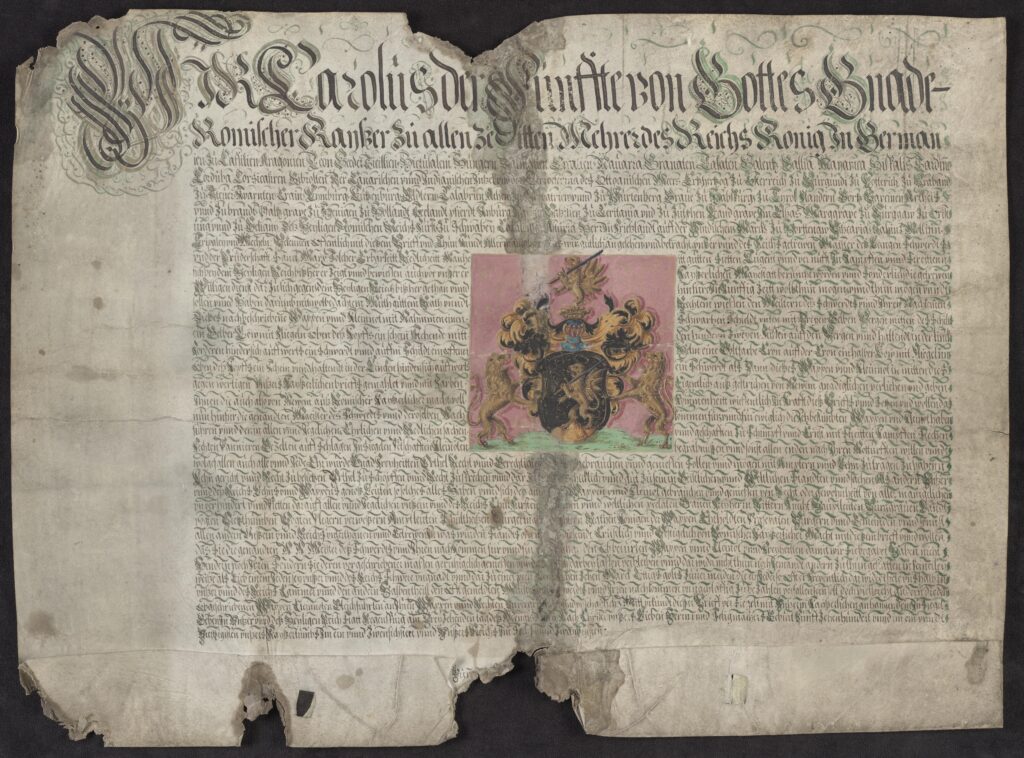
(Signature PA 111). A heartfelt thank-you to the archive staff for their swift and generous support throughout the process. For a full transcript, please refer to the Appendix of this article.
A Close Inspection of the 1541 Privilege
Different to the Gießen vidimus, which is penned mostly in a hasty cursive, this original privilege is rendered entirely in chancery script, lavishly illuminated with gold that has since weathered into verdigris. At its heart shines a candy-colored coat of arms, once again adorned with opulent golden diapering. Beyond the details provided in the blazon, we now discern that the mantling is black and gold (heraldically described as sable and or), and that the shield is flanked by two supporters: golden lions with forked tails, standing upon a patch of naturalistic grass.
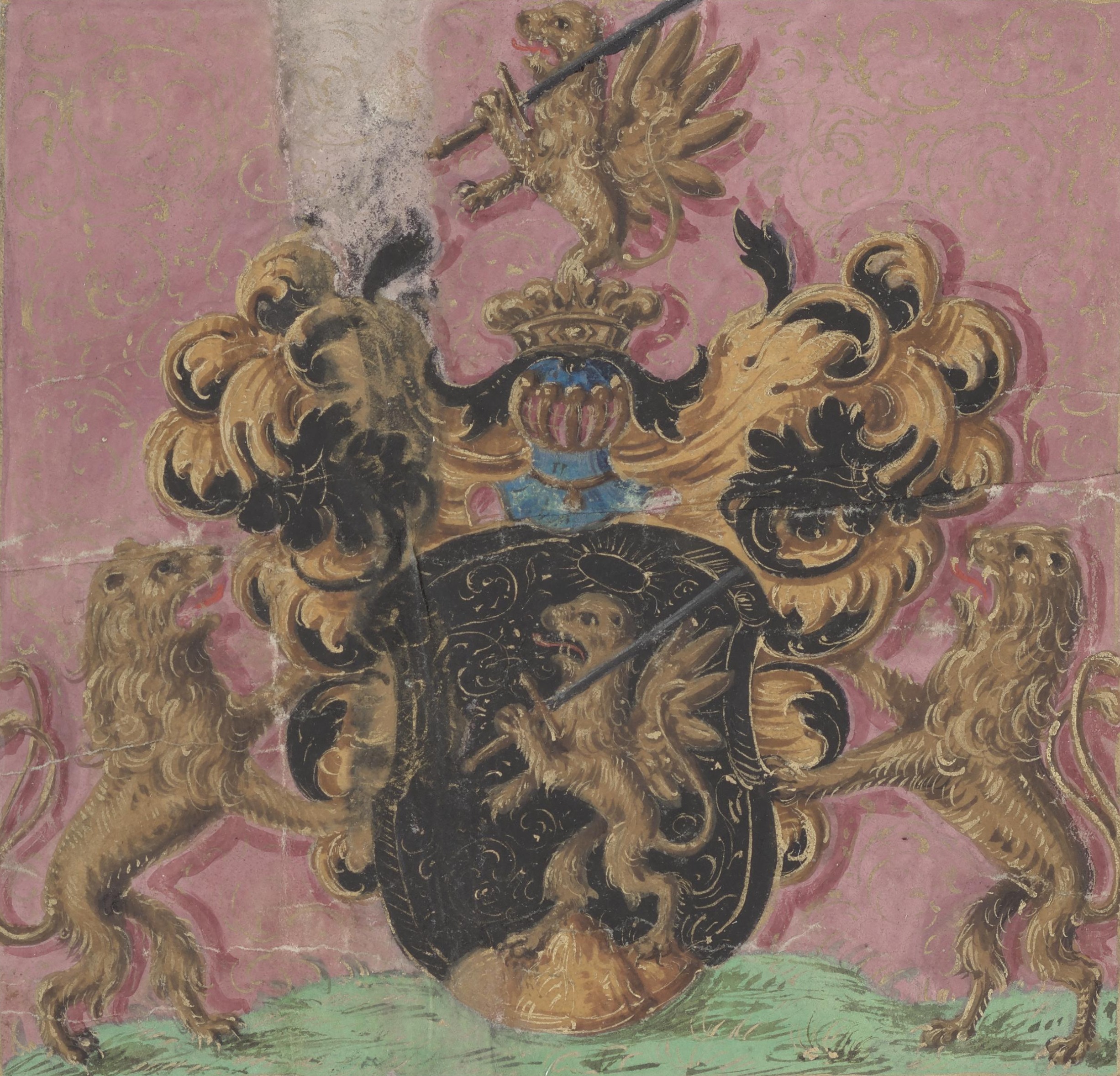
For the heraldically inclined, I’m attaching my attempt of a blazon. In case you’re unfamiliar, a blazon is a formulaic description of a coat of arms written in heraldic jargon, designed so that someone could recreate the arms without ever seeing them. The syntax is somewhat unusual, while colors and directions are traditionally given in French.
- Shield: Sable, upon a trimount Or a lion of St. Mark rampant Or holding in its sinister paw a longsword proper.
- Helmet: Open.
- Mantling: Sable doubled Or.
- Crest: A lion of St. Mark rampant Or holding in its sinister paw a longsword proper.
- Supporters: Two lions with forked tails Or upon grass proper.
The text emphasizes the guild’s longstanding service, loyalty, and virtue in martial matters and its role within the Empire. Charles V. elevated the guild’s civic status and allowed its members and descendants to enjoy legal and social privileges, including the right to bear and display the arms freely, exercise certain judicial rights, and participate in both martial and ceremonial functions with recognized honor. A full transcript and translation are contained in the Appendix.
The charter’s edges bear visible signs of age and repeated handling. Most conspicuous is the vacant space at the lower margin, where signature and seal once resided. A pronounced dark streak cuts across the center and through the arms, likely the result of water damage incurred during storage.
Yet despite these traces of centuries, the charter’s magnificence endures. Its artistry and heraldic detail continue to command attention, and the wear it carries does little to diminish its lasting grandeur.
Civic Identity and the Marxbrüder Legacy
This rediscovery offers more than aesthetic or archival value – it deepens our understanding of the civic identity of Frankfurt and the Holy Roman Empire.
The richly detailed coat of arms, now revealed in full tincture, sheds light on the Marxbrüder’s iconography while affirming their elevated status and imperial recognition. For heraldry, it presents a notably complete and imperially sanctioned guild armorial charter, rare in both its preservation and detail. And for Frankfurt’s cultural history, it evokes a moment when civic ambition, bolstered by martial skill and political sway, began appropriating the symbols and status once reserved for nobility. Such charters were not merely administrative, but performative declarations of prestige and belonging.
This charter also came to light thanks to the exemplary support of the State Archive of the Canton of Basel-Stadt. From my initial inquiry to the delivery of the reproduction, the entire process (including restoration and high-resolution digitization) was completed within days. The staff were not only exceptionally helpful, they also uploaded the high-resolution digital reproduction I had ordered to their archive database, where it now is accessible for free to anyone: Wappenbrief Karl V. für die Meister des Schwerts
I warmly recommend visiting this page and viewing the document for yourself, ideally on a large, high-resolution display.
Looking Ahead: The Augmented Arms of 1670
I am thrilled to have rediscovered the lost Marxbrüder coat of arms from 1541 and will be sharing more in the coming weeks. The next article will focus on the 1670 augmented version by Leopold I. Stay tuned!
Appendix A: Transcription of the 1541 Privilege by Charles V. in Regensburg (created by me, supported by Transkribus)
Wir Carolus der Fünfte von Gottes Gnade-
Römischer Kaÿßer zu allen Zeitten Mehrer des Reichs König in German
ien zu Castilien, Aragonien, Leon, Beeder Sicillien, Hierusalem, Hungern, Dalmatien, Croatien, Nauarra, Granaten, Taläten, Valentz, Gallia, Mayarica, Hispalis, Sardiñe,
Corduba, Corsicasiren, Gibrolten, Der Canarischen vnnd Indianischen Inßel, vnd der Terrae firmae des Ottoanischen Meers, Ertzhertzog zu Österreich, zu Burgundi, zu Lotterich, zu Braband,
zu Steuer, Krärnten, Crayn, Lymburg, Lützenburg, Geldtern, Calabrien, Athen, zu Neopatrien vnnd zu Würtenberg, Graue zu Habspurg, zu Tyrol, Flandern, Görtz, Barcinen, Artheis
vnnd zu brandt, Pfaltzgrave zu Henigen, zu Hollandt, Seelandt, pfierdt, Kyburg, Namur, Raßilien, zu Ceritania vnd zu Zutphen, Landgrave In Elßas, Marggrave zu Burggaw, zu Orist
ung vnnd zu Gelianÿ, deß Heÿligen Römischen Reichs Fürst zu Schwaben, Catalonien, Asturia, Herr In Frießlandt, auff der Windischen Marck, zu Horttenaw, Bißcaria, Sahinz, Mollinn,
Tripaleÿ vnd Mecheln: Bekennen öffentlich mit dießem Brieff vnd Thun Kundt Allermanigliche das wir gütlich angesehen vnd betracht unßer vnnd des Reichs getrewen Maister deß Langen Schwerdts
vnd der Brüderschafft Sanct Marx solcher Erbarkeitt, Redlicheitt, Manheitt, gutten Sietten, Tugent vnnd vernunfft in Kampffen vnnd Streittenn
sich bey dem Heÿligen Reich bißherer zeigt vnd bewiessen auch vor vnßerer Kaÿserlichen Maÿestatt berümht worden vnnd sonderlich die getrewen
Willigen dienst darzu sich gegen dem Heyligen Reiech bißher gethan unnd hinfüro in künftig zeitt wollthun mögen, unnd thun mögen unndt
sollen und haben darumb mit wolbedachtem Muth guttem Rath unndt rechtem wiellen den Meistern deß Schwerdts und ihren Nachkomen
dießes nachbeschriebene Wappen und Kleinnot mit Nahmmen einen schwartzen Schieldt unten mit dreyen gelben Bergen mitten des Schilts
ein gelber Löw mit Fliegeln oben des Kopffs ein Schein stehend mitt den hindern zweyen Füssen auff den Bergen, unnd haltendt in der linck
vorderen hinder sich auffwerts ein Schwerdt unnd auffm Schildt ein offener Helm, eine goltfarbe Cron, auff der Cron ein halber Löw mit Fliegelnn,
oben deß Kopffs ein Schein unnd haltendt in der Lincken hinder sich auffwerts ein Schwerdt als dann dießes Wappen unnd Kleinnot in mitten dies
gegenwertigen unßers Kayßerlichen brieffs gemahlet unnd mit farben eigentlich außgestrichen von Newem gnadiglichen verliehen und geben
Ihnen die auch also Newem auß Römischer Kaÿßerlicher matchvoll Kommenheit wiessentlich In Krafft dieß Brieffs vnnd setzen und wollen daß
nun hinfür die genandten Maeister des Schwerdts vnd deroselben Nachkommen für vnnd für ewiglich die jetzbestimbten Wappen vnd Kleinot haben
führen vnnd den in allen vnnd Iegelichen Ehrlichen vnnd Redlichen Sachen vnnd geschafften zu Schimpff vnnd Ernst, mit Streitten, Kampfen, Stechen,
Fechten, Vannieren, Gezelten, auffschlagen, Insiegelen, Petschafften, Kleinoten, Begräbnüßen vnnd sonst allen enden nach Ihrenn Nottürften, willen vnndt
wolgefallen, auch alle vnnd jede Ehrwürde, Gnad, Freyheitten, Vrthel, Recht vnnd Gerechtigkeit haben, gebrauchen vnnd geniessen sollen vnnd mögen mit Ämptern vnnd Lehn zu tragen zu habenn
Lehn gericht vnnd Recht zu besietzen, Vrthel zu schöpffen vnnd Recht zu sprechen vnnd darzu tauglich schicklich vnnd gut zu sein, in Geistlichen vnnd Weltlichen Ständten vnd sachen Als andern Unßer
vnnd deß Reichs Lehens vnnd Wappens genoß Leuthen so solches alles Haben vnnd sich deß auch Ihres Wappen und Cleinot gebrauchen vnnd geniessen von Recht oder gewohnheitt von aller maniglichen
unverhindert vnnd biettenn darauff allen vnnd Iegelichen vnßern vnnd des Reichs Churfürsten geistlichen vnnd weltlichen prelaten, GraIen, Freyherrn, Rittern, Knecht, Hauptleutten, Burggrauen, Landt
vögten, Vießthumben, Vögten, Pflegern, verweßern, Amptleuten, Schultheißen, Bürgermaistern, Richtern, Räthen, Königen der Wappen Erholdten Praesevaten, Bürgern vnnd Gemeinden, vnnd sonst
allen andern Unßern vnnd des Reichs unterthanen vnnd Getrewen In was würden, standts oder wesens die seindt Ernstlich, vnnd Vestigelich von Römischer Kayßerlicher Macht mit dießem brieff, vnnd wollen
das sie die genandten M. M. Meister deß Schwerdts vnnd Ihren nachKommen für vnnd für ewiglich an den obberurten Wappen vnnd Cleinot, unnd Freyheitten darmit wir sie begabet Haben nicht
Hindern noch Irren, sondern sie deren vorgeschriebener massen geruhigelich geniessen vnnd ganzlich darbeÿ lassen verbleiben vnnd dar wider nicht thun noch Iemandt andern zu thun gestattenn in keinerleÿ
weiße als Lieb einem Ieden seÿ vnßer vnnd des Reichs schwere ungnadt und darzu einer peen von lichen [?] zehen Marck Löttigs golts zu vermeiden die ein Ieder so offt er Freventlich darwider thete uns halb in
vnßer vnnd des Reichs Cammer unnd den andern Halben theill den Offt gemeldten Maistern des Schwerdts vnnd Irren nachkommen unnachlässig zu bezahlen verfallen sein soll doch vielleicht andern die den
obgeschriebenen Wappen und Cleinnoten Gleichführten an Ihren Wappen vnnd Rechten vnvergrifflich vnnd unschädlich. Mitt urkundt dießer Brieff versiegelt mit Vnßerm Kaÿßerlichen anhängendem Insiegel
Geben in Vnßer vnnd deß Heÿligen Reich Statt Regenspurg am Dreÿzehenden tag deß Monats Maÿ Nach Christi vnßers Lieben Herrn vnnd Seligmachers Geburt Fünffzehenhundert vnnd im ein vnndt
viertzigisten vnßers Kaÿßertumbs Im ein vnnd Zwensichsten vnnd Vnßers Reichs im sechs vnnd zwantzigsten.
Appendix B: Translation of the 1541 Privilege by Charles V. in Regensburg (created by me, supported by ChatGPT)
We, Charles the Fifth, by the Grace of God Roman Emperor, ever the augmenter of the Empire, King of Germany, of Castile, Aragon, Leon, both Sicilies, Jerusalem, Hungary, Dalmatia, Croatia, Navarre, Granada, Toledo, Valencia, Galicia, Majorca, Seville, Sardinia, Córdoba, Corsica, Gibraltar, the Canary and the Indies, and of the mainland of the Ottoman Sea, Archduke of Austria, of Burgundy, of Lorraine, of Brabant, of Styria, Carinthia, Carniola, Limburg, Luxembourg, Guelders, Calabria, Athens, of Neopatras, and of Württemberg, Count of Habsburg, of Tyrol, of Flanders, Gorizia, Barcino, Artois, and of Brand, Count Palatine of the Rhine, of Holland, Zeeland, Friesland, Kyburg, Namur, Rassilien, of Cerdanya and Zutphen, Landgrave in Alsace, Margrave of Burgau, of Orist and of Gellany, Prince of the Holy Roman Empire in Swabia, Catalonia, Asturias, Lord in Friesland, on the Windic March, of Pordenone, Biscay, Sahinz, Mollinn, Tripaley, and Mechelen etc:
We publicly acknowledge with this letter and make known to all people that we have kindly considered and examined our loyal and faithful Masters of the Long Sword and the Brotherhood of Saint Mark, for such nobility, honesty, courage, good customs, virtue, and wisdom in battles and conflicts as they have so far shown to the Holy Empire and have proven before our Imperial Majesty, and especially the faithful voluntary service they have performed for the Holy Empire, and will continue to perform in the future.
Therefore, with well-considered courage, good counsel, and proper will, we grant to the Masters of the Sword and their descendants the following coat of arms and insignia: a black shield with three yellow mountains at the bottom of the shield, a yellow lion with wings in the middle of the shield, a halo above its head, standing with its hind legs on the mountains, holding in its front left paw a sword pointing upward, and on the shield an open helmet, a golden crown, on the crown a half lion with wings, above its head a halo, holding in its left hind paw a sword pointing upward.
This coat of arms and insignia, depicted in the middle of this present Imperial letter and newly painted and colored, are graciously granted and given. Henceforth, the aforementioned Masters of the Sword and their descendants may bear this coat of arms and insignia for all time, and in all honorable and proper matters and affairs, both in play and in earnest, whether in fights, duels, jousts, fencing, mustering, setting up tents and camps, sealing documents, using signets, keeping small treasures, arranging burials, and in all other things according to their needs and wishes, and enjoy all honors, privileges, freedoms, judgments, rights, and justice, with offices and fiefs to hold and exercise.
They shall possess jurisdiction and rights, render judgments and administer justice, and be suitable, capable, and good in both spiritual and worldly matters, just as other people who enjoy the fiefs and arms of our Empire do. They may use and enjoy their coat of arms and insignia by right or custom without hindrance from anyone. We command all our and the Empire’s electors, spiritual and secular prelates, counts, barons, knights, lieutenants, burgraves, local governors, stewards, officials, mayors, judges, councils, kings, and citizens, and all other subjects of the Empire, to recognize this seriously and firmly by Imperial authority and not obstruct or interfere with the Masters of the Sword and their descendants in the exercise of the above-described arms and insignia.
Anyone who opposes this shall incur the severe displeasure of our Imperial authority and a fine of ten marks of Lüttich gold, to be paid half to our Imperial chamber and half to the aforementioned Masters of the Sword and their descendants, without prejudice to those who lawfully bear similar arms and insignia.
This letter is sealed with our Imperial seal, given in our and the Holy Empire’s city of Regensburg on the thirteenth day of the month of May, in the year of Christ 1541, in the 21st year of our Emperorship, and the 26th of our Empire.
